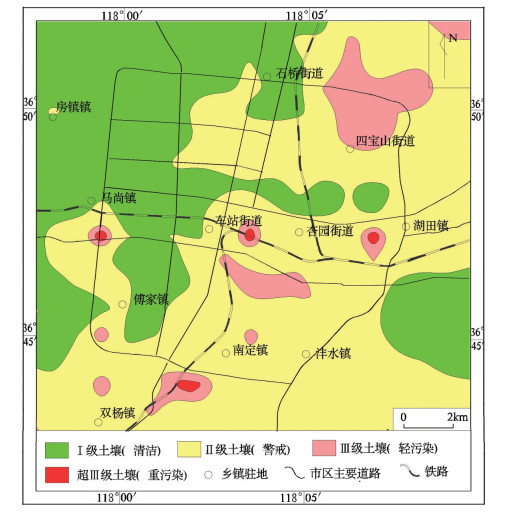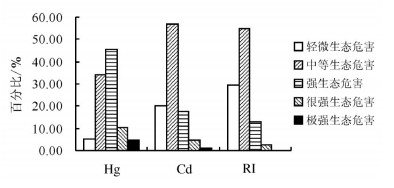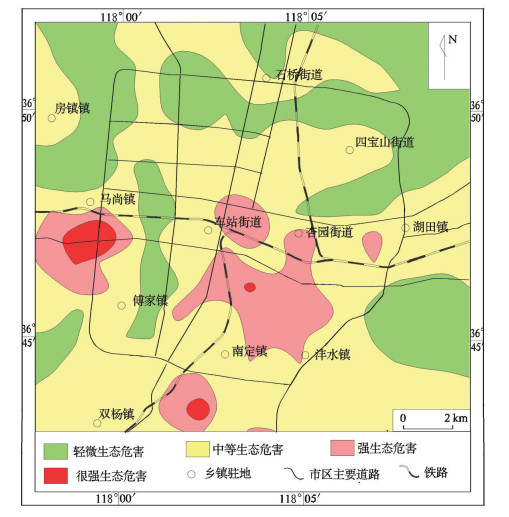A study of geochemical characteristics and ecological risk of elements in soil of urban and suburban areas of Zibo City, Shandong Province
-
摘要:
以淄博城市土壤为研究对象,应用统计学方法对土壤地球化学特征进行研究,采用单因子指数和尼梅罗综合指数法对土壤环境质量进行评价,同时采用Hakanson提出的潜在生态危害指数法对土壤重金属的潜在生态危害进行评价,并对其产生的生态环境效应进行研究。结果表明:Hg、Cd、S、Pb、Se、OrgC等元素或指标在表层土壤中的含量明显大于深层,二者间相关性较差,且表层土壤存在明显碱化特征,受到不同程度人为活动影响;单因子评价Cd、Cu、Hg、Ni、Zn都出现污染,其中Cd污染面积最大,达到5.11%,综合污染评价土壤环境质量整体良好,污染土壤占9.84%,其形成可能与工业生产和人类活动有关;潜在生态危害程度最强的重金属是Hg、Cd,局部地段已经达到强、极强潜在生态危害水平,综合重金属潜在生态危害水平整体表现为中等,其轻微、中等、强、很强生态危害的比例分别为29.32%、55.02%、12.85%、2.81%,从空间分布上来看,强、很强潜在生态危害区分布与各类工业空间布局相吻合,种植的蔬菜中Cd、Pb、Zn、Hg等重金属有不同程度超标现象,需加强对土壤及农产品进行协同监测与评价,防止土壤重金属污染加重影响人体健康。
Abstract:Determination of chemical elements was performed in urban and suburban areas of Zibo City. For this purpose, the statistical principles, univariate and multivariate Nemerow comprehensive index, Hakanson potential ecological risk methods were applied in order to assess the geochemical characteristics of these elements, soil environment quality, potential ecological risks, and their impact on environment and crops. The investigation reveals that the values of Hg, Cd, S, Pb, Se, OrgC and some other components at the surface soil are significantly higher than those in deep soil, that there exists poor correlation of elements and index between surface and deep soil, and surface soil samples, affected by different degrees of human activities, are obviously alkaline. Furthermore, single pollutant evaluation shows various degrees of contamination of Cd, Cu, Hg, Ni, and Zn in soil, in which the pollution area of Cd is the biggest, accounting for 5.11% of the whole city, and the comprehensive pollutant evaluation of overall soil is effective, which reveals that 9.84% of the soil samples have been contaminated, and its formation may be associated with industrial production and human activities. Heavy metals Hg, Cd seem to be the highest potential ecological risk elements, and local area has reached strong or extreme potential ecological risk level, whereas the comprehensive potential ecological risk evaluation is overall medium, with the mild, moderate, strong and extreme harm area accounting for 29.32%, 55.02%, 12.85%, 2.81%, respectively. From the spatial distribution, strong and extreme potential ecological risk areas coincide types of industrial space layout; furthermore, the values of Cd, Pb, Zn, Hg and other heavy metals of the crop samples exceed the standard limits in different degrees, which suggests that the soil and agricultural products should be monitored and evaluated cooperatively to prevent heavy metal pollution and aggravate human health.
-
1. 引言
城市是一个复杂、开放的生态系统,是人类文明的产物。城市的形成和发展是人类社会发展的集中缩影,随着城市进程的发展,人类活动将工业废弃物、建筑与生活垃圾、汽车尾气和交通运输等各类大量有机和无机污染物带入城市环境中,而土壤则成了这些污染物的主要承载者(崔邢涛等, 2011, 2015, 2016; 蔡奎等, 2016;徐友宁等, 2007, 2013),并通过大气、水体和食物链在人体内积累,危害人体健康;同时由于土壤重金属污染难以被察觉,且不易降解,具有长期性和不可逆特点,危害严重(王存龙等, 2015),因此研究城市及周边土壤重金属的分布特征、植物中的地球化学行为,并对其环境质量进行评价是必要的。目前,自然资源部门开展的城市土壤重金属研究,集中在2002年以来开展的生态地球化学调查工作上,研究了成土母质和成土过程对城市土壤重金属含量的影响(代杰瑞等, 2011a, 2011b;郭海全等, 2011;郑喜坤等, 2002;王学求等, 2016),研究城市污染源对郊区土壤重金属的影响(张磊, 2004; 姚德等, 2008)以及研究城市经济发展对城市不同区域土壤重金属的污染态势(赵琦等, 2002; 彭秀红等, 2006; 廖启林等,2009),国内也有不少学者对城市土壤重金属的来源和迁移转化规律进行初步研究(代杰瑞等, 2014, 2015; 管后春等, 2013; 杨孝智等, 2011; 姚青等, 2013)。以上研究也仅是从土壤中重金属含量为基础,研究其分布和迁移特征,而基于城市土壤重金属与重点污染源空间分布的关系及其生态效应的研究较少涉及,对于淄博城市及周边土壤重金属污染特征及生态效应的研究未见报道。
淄博市地处山东中部,交通发达,是山东省重要的交通枢纽城市。淄博是全国重要的石油化工、医药生产基地和建材产区,也是山东省工业大市,存在一定程度的结构性污染;近10年来城市建筑业发展迅速,机动车数量也迅速增加。这些污染源将大量污染物带入到城市环境中,造成城市环境污染,土壤则成了这些污染物的主要承载者。因此在对淄博城市土壤元素含量特征研究为基础,对土壤重金属污染和潜在生态危害性进行评价,研究重金属污染分布与重点污染源的空间分布关系并对其所产生的生态效应进行评价,这对淄博市经济规划发展具有重要的理论和实际意义。
2. 工作方法
2.1 样品采集与分析
本次研究以淄博城市及周边为研究区域,按照中国地质调查局多目标规范要求,按网格布样法采样。以1件/km2的密度在绿化带、公园等采集人工改造时间较长的0~20 cm的表层土壤样品249件,样品为在预布点范围(半径为20 m)内3~5个采样点所采集土壤样品的混合样;同时以1件/4 km2的密度在老公园、老院落、老园林等采集100 cm以下基本未受扰动的深层(原始)土壤样品36件,采样点分布见图 1。
采集的样品装在干净的布袋中,重量约1.5 kg,在日光下自然风干。干燥后的样品用木槌适当敲打,达到自然粒级状态;样品过20目尼龙筛,截取小于0.8 mm粒级组分样品200 g装入带编号的纸袋中。样品由武汉岩矿测试中心采用X射线荧光光谱、等离子光谱、氢化物原子荧光光谱、发射光谱等一整套大型精密仪器进行测试,分析As、Cd、Co、Cr、Cu、F、Hg、Mn、Ni、Pb、Ti、V、Zn、Se、Cl、Br、I、S、SiO2、Al2O3、TFe2O3、MgO、CaO、Na2O、K2O、有机碳和pH值,共27项指标。
植物取样在淄博郊区及结合带的农用大田或蔬菜种植基地,采集韭菜、茄子、豆角、地瓜、马铃薯、大葱等各类蔬菜样品36件。样品用去离子水洗净,用捣碎机捣碎打浆后,用浓HNO3消解。采用电感耦合等离子体质谱法(ICP-MS)分析Cd、Cu、Pb、Zn,X射线荧光光谱法(XRF)分析Cr,原子荧光光谱法(AFS)分析Hg、As。
采用了标准样、密码样、监控样等多种监控手段,保证了分析采用了标准样、密码样、监控样等多种监控手段,保证了分析质量的可靠性,各元素的分析方法、检出限、合格率满足《生态地球化学评价样品分析技术要求(DD2005-03)》。
2.2 数据处理及图件编制
多目标区域地球化学调查采用了表层和深层土壤双层网格化采样。根据中国地质调查局多目标区域地球化学调查规范(DZ/T 0258—2014),土壤基准值是指未受人类影响(自然条件下)的土壤原始沉积环境(第Ⅰ环境)地球化学元素含量,也称为土壤元素本底值,以深层土壤元素含量表征。土壤背景值是指自然应力和人类活动共同作用影响下(第Ⅱ环境)区域表层土壤的含量值,实际上是成土母质组成、成土过程中元素迁移重分配、人为扰动污染等各种因素长期综合作用的结果,以表层土壤元素含量表征。
采用中国地质调查局发展研究中心开发的GeoMdis地球化学信息系统和Excel对研究区土壤元素(指标)含量特征进行统计。表层土壤地球化学背景值的求取首先对数据频率分布形态进行正态检验,服从正态或对数正态分布的,分别用算术平均值和几何平均值代表基准值;不服从正态分布的,则按算术平均值加减3倍标准离差反复剔除,平均值或几何平均值代表背景值;剔除后仍不满足正态分布的,则以众值代表背景值。深层土壤基准值的求取方法与背景值相同。利用中国地质大学研制的MapGIS软件制作综合评价图和解释图件。
3. 土壤地球化学特征
3.1 土壤元素含量统计特征
淄博市土壤基准值与背景值地球化学参数见表 1。
表 1 淄博城市土壤背景值和基准值地球化学参数统计Table 1. Geochemical parameter statistics of background and baseline values of soil in Zibo
除缺少背景值数据的元素外,与全国土壤A层丰度(鄢明才等, 1997)相比,淄博市表层土壤中Cd、Cl、Pb、Se、Cu、CaO、MgO、pH等元素或指标含量明显偏高,其中Cd、Pb为全国土壤A层丰度的2.14倍、1.35倍;与山东省土壤背景值(代杰瑞等, 2011b)相比,Br、Cd、Cl、Cu、Hg、I、Pb、S、Se、Zn、CaO、OrgC等元素(指标)明显偏高,是全省土壤背景值的1.23~ 2.11倍。
富集系数(背景值/基准值)反映了后期人类活动所造成元素含量的增加或亏损程度。由表 1可见,淄博市土壤中Hg、Cd、S、Pb、Zn、Br、Cu、Se、OrgC等多数元素或指标的富集系数大于1,其中表层土壤中Hg、Cd、S、Pb、Se、OrgC含量是深层土壤的1.56~3.48倍,且表深土壤中这些元素的相关系数均小于0.3,说明城市土壤已经受到一定程度的人为污染影响。而I、F、V、Mn、Cr、Ti和Al、Fe、K、Na等氧化物含富集系数接近1,且表层与深层土壤中元素(指标)的相关系数均大于0.4,人类活动对其影响相对较小。
土壤pH值虽不是元素,但却是表征土壤综合性质非常重要的一个指标,从表 1中可以看出,表层土壤pH值(8.58)高于深层土壤(8.09),具碱化特征;同时表层土壤CaO含量是深层土壤的1.18倍,CaO和CaCO3是石灰、水泥建筑降尘的特征元素,这类偏碱性物质向表层土壤释放可能是导致城市表层土壤碱化的原因之一。
3.2 土壤典型元素含量间的相关性分析
变异系数反映了土壤污染的均匀程度,而元素间的相关性分析则有助于解析污染来源。从表 2可见,表层土壤中Se与Cd、Pb、Zn间的相关系数分别为0.659、0.635、0.497,S与Cd、Pb、Zn间的相关系数分别为0.468、0.455、0.472,并且通过了0.01水平的显著性检验,通常如果元素间显著相关,则说明它们可能属于同一来源(He et al., 2002)。Se和S是燃煤的标识性元素(He et al., 2002; Lewis, 1985; 姚志良等, 2012),同时从表 1可以看出,Cd、Pb、Zn三元素变异系数超过0.40,显示了土壤中Cd、Pb、Zn污染与局部燃煤产生的环境污染有关。
表 2 淄博市表层土壤中元素含量相关系数Table 2. Correlation coefficients of the element content in surface soils of Zibo
从表 2可见,Hg元素与其他重金属元素间的相关性较差,说明Hg的积累特征比较独特,与其他元素外来污染的方式可能不同,土壤受Hg污染更为普遍和均一。As、Ni、Cu、Cr与其他元素间相关性均不十分显著,且具有变异系数不高,富集系数不大的特点,这说明四元素污染不严重,主要来源于自然背景或混合来源。
4. 土壤重金属污染与潜在生态风险评价
土壤重金属污染评价方法很多,有基于土壤环境质量标准(GB15618-1995)的单因子指数和尼梅罗综合指数法,环境风险因子法、潜在生态危害指数法、富集系数法等。本次评价采用单因子指数和尼梅罗综合指数法对淄博市区及周边土壤的污染现状进行评价,同时用潜在生态危害指数法对进行生态危害程度评价,并对郊区蔬菜重金属的生态风险性进行研究。
4.1 评价方法
4.1.1 单因子指数和尼梅罗综合指数法
以中国土壤环境质量标准(GB15618-1995)中的重金属含量限值为评价标准,按如下公式计算单因子指数。

(1) 
(2) 
(3) 
(4) 式中,Zi为单因子分指数;Xi为土壤中重金属元素含量;CⅠ、CⅡ、CⅢ为重金属元素i的土壤Ⅰ、Ⅱ、Ⅲ级环境质量标准,在不同的pH区间,分别采用不同标准值。
采用尼梅罗综合指数法进行综合环境质量评价,其计算公式为:

(5) 式中:I为尼梅罗综合污染指数;Zi为土壤中i元素单因子指数;Zi最大为单因子指数最大值,n为参评重金属元素个数。
根据土壤环境质量标准定义,符合土壤环境质量标准Ⅰ级的土壤定义为清洁,符合Ⅱ级的土壤定义为警戒,符合Ⅲ级的土壤定义为污染,符合超Ⅲ级的土壤定义为重污染,分级标准见表 3。
表 3 土壤污染评价分级标准Table 3. The grading standards of soil environmental quality
4.1.2 潜在生态风险指数法
不同重金属元素对农作物及人体健康的毒性不同(郭平等, 2005; 刘文新等, 1999; 马德毅等, 2003),正是基于这一点,瑞典科学家Hakanson(1980)从沉积学原理提出重金属潜在生态风险评价的方法,将不同重金属毒理效应与环境效应相联系,综合反映土壤重金属的潜在风险。其计算公式为:

(6) 
(7) 式中:RI为多种重金属潜在生态危害指数;Eri为第i种重金属的潜在生态危害指数;Tri为第i种污染物毒性响应系数;Cfi为第i重金属污染种指数;Ci为第i种重金属的实测浓度;Cni为评价重金属污染参比值。研究表明深层土壤元素含量在一定程度上可以代表表层土壤的原始沉积的元素含量(代杰瑞等, 2011b, 2015; 张春梅, 2006),本次研究Cni采用深层土壤平均值代表相应表层土壤未受污染的参比值。
Hakanson提出重金属潜在毒性与“释放度”(重金属在水中含量与在沉积物中含量的比值)有关,易于释放的重金属对生物毒性大。对毒性响应系数处理后确定值为:Hg=40,Cd=30,As=10,Cu=5,Pb=5,Ni=Cr=2,Zn=1。潜在生态危害程度指数划分见表 4。
表 4 Hakanson潜在生态危害程度指数划分Table 4. The Hakanson evaluation criteria of the potential ecological risk
4.2 评价结果与分析
4.2.1 土壤环境质量评价
从淄博市土壤重金属单因子污染评价结果来看(表 5),不同重金属污染状况有较大差异,污染程度依次为Cd>Ni>Hg>Zn>Cu>Pb>Cr>As,其中Cr、Pb均处于清洁警戒状态,As绝大部分区域处于清洁状态,只有0.79%处于警戒状态;Cd、Cu、Hg、Ni、Zn都出现污染,其中Cd污染面积最大,达5.11%。从尼梅罗综合污染指数评价结果(表 5)看,淄博市土壤环境质量整体属于清洁警戒范畴,但局部环境质量不容乐观,污染和重污染土壤面积占9.84%,主要分布在研究区中南部局部地段和四宝山街道北部(图 2),四宝山北部分布着石油化工厂、医药生产厂、钢铁厂、水泥制品厂等多家企业;中南部局部污染范围与热电厂、冶炼厂、化工厂、铝土厂、陶瓷产区等企业空间分布相一致。
表 5 淄博城市土壤重金属环境质量等级面积百分比(%)Table 5. Pollution grade area percentages of heavy metals in soils of Zibo
4.2.2 土壤潜在生态风险评价
土壤重金属单元素及综合潜在生态危害指数计算结果(表 6)表明,按单元素平均生态危害指数排序,危害程度从大到小依次为Hg>Cd>Pb>Cu>As>Zn>Cr>Ni,其中As、Cr、Cu、Ni、Pb、Zn危害指数最大值均小于40,潜在生态危害轻微。淄博城市土壤潜在生态危害较大的是Hg和Cd,危害指数变化范围分别为22.40~2387.20、20.75~335.89,局部出现极强生态危害区;综合潜在生态危害指数级别为中等生态危害,指数变化范围为65.97~ 2548.68。
表 6 土壤重金属潜在生态危害评价特征值统计Table 6. The characteristic values of the potential ecological risk evaluation of soil heavy metals
从Hg、Cd及综合潜在生态风险指数频率分布(图 3)可以看出,Hg潜在生态危害性最大,生态危害性轻微、中等、强、很强、极强的百分比分别是5.22%、34.14%、45.38%、10.44%、4.82%,整体为中等生态危害;Cd具有一定潜在生态危害性,其中轻微、中等、强、很强、极强的百分比分别是20.08%、57.03%、17.67%、4.42%、0.80%。综合重金属潜在生态危害水平整体表现为中等,其轻微、中等、强、很强的百分比分别为29.32%、55.02%、12.85%、2.81%,其空间分布见图 4。
从图 4可以看出,与土壤环境质量分区图相对比,潜在生态危害指数(RI)的空间分布更能体现淄博城市的污染态势,强和很强潜在生态危害区位于土壤环境质量为Ⅱ级的土壤区(警戒区)中,且涵盖了土壤环境质量为Ⅲ类(污染)和超Ⅲ类(重污染)区域。其分布在以下区域:(1)杏园—南定:是淄博重要工业区,如淄博铝土厂、水泥厂、化工厂、机械厂和多家热电厂均位于该区;(2)杨双镇东:主要分布在蓄电池厂周围,局部属很强潜在生态危害区,为少数样点Hg污染;(3)马尚镇南:是淄博市重要陶瓷产区,分布有众多的陶瓷生产厂;(4)火车站周边区域:以火车站为中心,形成椭圆状强潜在生态危害区,可能与火车站车流量大,汽车尾气污染有关, 污染元素主要为Hg、Pb、Cd。由以上分析可见,淄博城市强和很强潜在生态危害分布区与人类污染活动范围基本吻合,其形成可能与工业生产和人类活动有关。
4.3 生态环境效应评价
为了研究淄博城市土壤重金属污染对植物的影响,本次研究在中等、强和很强潜在生态危害区采集了有代表性的蔬菜样品36件,包括韭菜、茄子、豆角、地瓜、马铃薯、大葱等各类蔬菜样品各6件,进行重金属含量分析,同时根据国家食品卫生标准GB2762—2005 (中华人民共和国卫生部, 2005)对蔬菜质量进行评价。
从蔬菜样品在不同生态危害区内平均含量(表 7)可见,蔬菜中的Cd、Pb、Zn、As、Hg、Cu等重金属平均含量呈现出中等、强和很强潜在生态危害区依次升高的变化规律,其中很强生态危害区蔬菜中重金属含量均值是中等生态危害区的1.19倍(Zn)~ 4.02倍(Cd), 是强生态危害区的1.04倍(As)~3.44倍(Cd)。
表 7 不同生态危害区内蔬菜平均含量、超标率统计Table 7. The average concentrations and comparison with standards of heavy metals in wheat in different environmentdamaged areas
依据国家食品卫生限量标准,蔬菜中除As、Cu均未超标外,Cd、Pb、Zn、Hg在不同区域蔬菜中都有不同程度超标现象,其中很强潜在生态危害区内蔬菜超标率明显高于其他地区。综上所述,淄博城市土壤重金属污染物已迁移到蔬菜中,生态危害级别高的危害区内蔬菜中重金属含量也高,超标率也大。建议对土壤及农产品进行协同监测与评价,加强污染源监管,防止土壤重金属污染进一步加重影响农产品和人体健康安全。
5. 结论
(1)与全国土壤A层丰度值对比,淄博城市土壤中Cd、Cl、Pb、Se、Cu、CaO、MgO、pH等元素或指标含量明显偏高。表层土壤Hg、Cd、S、Pb、Se、OrgC受到一定程度的人为污染影响,其中Cd、Pb、Zn、S、Se污染主要与燃煤有关;As、Ni、Cu、Cr污染不严重,主要来源于自然背景或混合来源。
(2)淄博城市土壤环境质量整体良好,污染土壤仅占9.84%,主要分布在市区中南部局部地段和四宝山街道北部。采用潜在生态危害指数评价,土壤中Hg、Cd局部地段已经达到很强、极强潜在生态危害水平,其余元素危害轻微;综合重金属潜在生态危害水平属强、很强生态危害的比例分别为2.85%、2.81%,其空间分布与各类工业空间布局相吻合,其形成可能与工业生产和人类活动有关。
(3)土壤中蔬菜样品重金属平均含量和超标率与潜在生态危害指数正相关。淄博市局部土壤重金属污染物(Cd、Hg、Pb、Zn等)已迁移到蔬菜体内,有必要进一步对该区潜在危害评价结果为强—很强区的农作物进行抽样调查,或健全农产品污染物检测体系,以确保人民群众的身体健康。
-
表 1 淄博城市土壤背景值和基准值地球化学参数统计
Table 1 Geochemical parameter statistics of background and baseline values of soil in Zibo

表 2 淄博市表层土壤中元素含量相关系数
Table 2 Correlation coefficients of the element content in surface soils of Zibo

表 3 土壤污染评价分级标准
Table 3 The grading standards of soil environmental quality

表 4 Hakanson潜在生态危害程度指数划分
Table 4 The Hakanson evaluation criteria of the potential ecological risk

表 5 淄博城市土壤重金属环境质量等级面积百分比(%)
Table 5 Pollution grade area percentages of heavy metals in soils of Zibo

表 6 土壤重金属潜在生态危害评价特征值统计
Table 6 The characteristic values of the potential ecological risk evaluation of soil heavy metals

表 7 不同生态危害区内蔬菜平均含量、超标率统计
Table 7 The average concentrations and comparison with standards of heavy metals in wheat in different environmentdamaged areas

-
Cui Xingtao, Luan Wenlou, Niu Yanbin, Li Suimin, Song Zefeng. 2011. An assessment of the heavy metal pollution and potential ecological hazards in urban soil of Tangshan City[J]. Geology in China, 38(5):1379-1386(in Chinese with English abstract). http://en.cnki.com.cn/Article_en/CJFDTOTAL-DIZI201105025.htm
Cui Xingtao, Luan Wenlou, Song Zefeng, Ma Yunchao. 2016. A study of the spatial distribution and source of heavy metals in urban soil in Shijiazhuang City[J]. Geology in China, 43(2):683-690(in Chinese with English abstract). https://www.researchgate.net/publication/311433351_A_study_of_the_spatial_distribution_and_source_of_heavy_metals_in_urban_soil_in_Shijiazhuang_City
Cui Xingtao, Wang Xueqiu, Luan Wenlou. 2015. An analysis of modes of occurrence and biological availability of the heavy metal elements in soil of the central and southern plain in Hebei[J]. Geology in China, 42(2):655-663(in Chinese with English abstract). http://en.cnki.com.cn/Article_en/CJFDTotal-DIZI201502023.htm
Cai Kui, Duan Yamin, Luan Wenlou, Li Qian, Ma Yunchao. 2016.Geochemical behavior of heavy metals Pb and Hg in the farmland soil of Hebei plain[J]. Geology in China, 43(4):1420-1428(in Chinese with English abstract). http://www.en.cnki.com.cn/Article_en/CJFDTotal-DIZI201604026.htm
Dai Jierui, Pang Xugui, Yu Chao, Liu Huafen, Wang Zenghui. 2011a.Geochemical features and contamination assessment of soil elements in east Shandong Province[J]. Geology in China, 38(5):1387-1395(in Chinese with English abstract). http://en.cnki.com.cn/Article_en/CJFDTOTAL-DIZI201105026.htm
Dai Jierui, Pang Xugui, Yu Chao, Wang Cunlong, Wang Zenghui, Hu Xueping. 2011b. The study of elements on geochemical baseline and background values and the enrichment characteristics in soil in eastern Shandong Province[J]. Geochemistry, 40(6):577-587 (in Chinese with English abstract).
Dai Jierui, Zhu Decheng, Pang Xugui, Wang Xue. 2014. Geochemical characteristics and pollution sources identification of the nearsurface atmosphere dust-fall in Jining City[J]. China Environmental Science, 34(1):40-48 (in Chinese with English abstract). https://www.researchgate.net/publication/287741671_Geochemical_features_and_contamination_assessment_of_soil_elements_in_East_Shandong_Province
Dai Jierui, Zhu Decheng, Pang Xugui, Yang Lizhi, Peng Guanfeng, Ning Zhenguo. 2015. Geochemical characteristics and environmental quality of soil elements in Jinan City[J]. Geology in China, 42(1):308-316 (in Chinese with English abstract). https://www.researchgate.net/publication/281962455_Geochemical_characteristics_and_environmental_quality_of_soil_elements_in_Jinan_City
Guan Houchun, Li Yunhuai, Peng Miaozhi, Liu Daobin. 2013. The evaluation of heavy metal pollution and its potential ecological risk of urban topsoil in Huangshan City[J]. Geology in China, 40(6):1949-1958 (in Chinese with English abstract). https://www.researchgate.net/publication/286689310_The_evaluation_of_heavy_metal_pollution_and_its_potential_ecological_risk_of_urban_topsoil_in_Huangshan_City
Guo Haiquan, Yang Zhiong, Li Hongliang, Ma Wenjing, Ren Jiufeng. 2011. Environmental quality and anthropogenic pollution assessment of heavy metals in topsoil of Hebei Plain[J]. Geology in China, 38(1):218-225(in Chinese with English abstract).
Guo Ping, Xie Zhonglei, Li Jun, Zhou Linfeng. 2005. Specificity of heavy metal pollutionand the ecological hazard in urban soils of Changchun City[J]. Scientia Geographica Sinica, 5(1):108-112 (in Chinese with English abstract). doi: 10.1007/s12404-010-0319-y
Hakanson L. 1980. An ecological risk index for aquaic pollution control-a sedimento logical approach[J]. Water Research, 14(2):975-978. http://jz.docin.com/p-220199857.html
He B, Liang L N, Jiang G B. 2002. Distributions of arsenic and selenium in selected Chinese coal mines[J]. Science of the Total Environment, 296(1/3):19-26. https://www.deepdyve.com/lp/elsevier/distributions-of-arsenic-and-selenium-in-selected-chinese-coal-mines-AGe1Qpugib
Lewis J. 1985. Leand poisoning:a historical perspective[J]. EPA Journal, 11:15-18.
Liao Qilin, Hua Ming, Jin Yang, Huang Shunsheng, Zhu Bowan, Wang Zhihua, Pan Yongmin. 2009. A preliminary study of the distribution and pollution source of heavy metals in soils of Jiangsu Provin[J]. Geology in China, 36(5):1163-1174(in Chinese with English abstract). http://en.cnki.com.cn/Article_en/CJFDTotal-DIZI200905022.htm
Liu Wenxin, Luan Zhaokun, Tang Hongxiao. 1999. Environmental assessment on heavy metal pollution in the sediments of lean river with potential ecological risk index[J]. Acta Ecologica Sinica, 9(2):206-211(in Chinese with English abstract). doi: 10.1007/s12011-008-8300-y
Ma Deyi, Wang Juying. 2003. Evaluation on potential ecological risk of sediment pollution in main estuaries of China[J]. China Environment Science, 23(5):521-525(in Chinese with English abstract). https://www.researchgate.net/publication/291300380_Evaluation_on_potential_ecological_risk_of_sediment_pollution_in_main_estuaries_of_China
Peng Xiuhong, Ni Shijun, Fang Min. 2006. Evaluation of impact on heavy metals in soil in urban industry area[J]. Guangdong Trace Element Science, 13(11):44-47(in Chinese with English abstract). https://www.researchgate.net/publication/303509277_Evaluation_of_accumulation_and_concentration_of_heavy_metals_in_different_urban_roadside_soil_types_in_Miranda_Park_Sydney
The Minister of Health of the People's Republic of China. 2005. GB2762-2005 Tolerance limits of contamination in foods[EB/OL]. http://www.doc88.com/p-89492347988.html, 2012-09-26.
Wang Cunlong, Zeng Xiandong, Liu Huafeng, Yang Liyuan, Wang Hongjin, Pang Xugui. 2015. The present situation of soil environmental quality and the distribution and migration regularity of heavy metals in soil of Yantai[J]. Geology in China, 42(1):317-330(in Chinese with English abstract). https://www.researchgate.net/publication/282285329_The_present_situation_of_soil_environmental_quality_and_the_distribution_and_migration_regularity_of_heavy_metals_in_soil_of_Yantai
Wang Xueqiu, Zhou Jian, Xu Shanfa, Chi Qinghua, Nie Lanshi, Zhang Bimin, Yao Wensheng, Wang Wei, Liu Hanliang, Liu Dongsheng, Han Zhixuan, Liu Qingqing. 2016. China soil geochemical baselines networks:data characteristics[J]. Geology in China, 43(5):1469-1480 (in Chinese with English abstract). https://bigdatawg.nist.gov/_uploadfiles/M0363_v1_4695311424.docx
Xu Youning, Zhang Jianghua, Ke Hailing, Liu Runping, Chen Huaqing. 2013. Cd contamination of farmland soil in a gold mining area and its environmental effects[J]. Geology in China, 40(2):636-643 (in Chinese with English abstract). http://en.cnki.com.cn/Article_en/CJFDTOTAL-DIZI201302028.htm
Xu Youning, Zhang Jianghua, Liu Ruiping, Ke Hailing, Li Yujing. 2007. Environmental effects of heavy metal pollution of farmland soils in gold mining areas[J]. Geology in China, 34(4):716-722(in Chinese with English abstract). http://en.cnki.com.cn/Article_en/CJFDTOTAL-DIZI200704024.htm
Yan Mingcai, Gu Tiexin, Chi Qinghua, Wang Chunshu. 1997.Abundance of chemical elements of soils in China and supergenesis geochemistry characteristics[J]. Geophysical and Geochemical Exploration, 21(3):161-167 (in Chinese with English abstract). http://en.cnki.com.cn/Article_en/CJFDTOTAL-WTYH199703000.htm
Yang Xiaozhi, Chen Yang, Xu Diandou, He Tingting, Ma Lingling, Li Jie, Nie Changming. 2011. Characteristics of heavy metal pollution and health risk assessment in subway dust in Beijing[J]. China Environmental Science, 31(6):944-950 (in Chinese with English abstract). https://www.researchgate.net/publication/287632030_Characteristics_of_heavy_metal_pollution_and_health_risk_assessment_in_subway_dust_in_Beijing
Yao De, Sun Mei, Yang Fugui, Jiang Hengyi, Li Gongsheng, Ding Chunxiao.2008. Environmental geochemistry of heavy metals in urban soils of Qingdao City[J]. Geology in China, 35(3):539-550(in Chinese with English abstract). doi: 10.1007/s10661-007-9850-8
Yao Qing, Han Suqin, Cai Ziying. 2013. The pollution characteristics and potential ecological risk of heavy metals in PM2. 5 during heating season in Tianjin[J]. China Environmental Science, 33(9): 1596-1600 (in Chinese with English abstract). https://www.researchgate.net/publication/286742849_The_pollution_characteristics_and_potential_ecological_risk_of_heavy_metals_in_PM25_during_heating_season_in_Tianjin
Yao Zhiliang, Zhang Minghui, Wang Xintong, Zhang Yingzhi, Huo Hong, He Kebin. 2012. Trends in vehicular emissions in typical cities in China[J]. China Environmental Science, 32(9):1565-1573 (in Chinese with English abstract). https://www.researchgate.net/publication/285941432_Trends_in_vehicular_emissions_in_typical_cities_in_China
Zhang Chunmei. 2006. Soil Heavy Metals Pollution and Ecological Risk Assessment in the City[D]. Hangzhou: Zhejiang University(in Chinese with English abstract).
Zhang Lei, Song Fengbin, Wang Xiaobo. 2004. Heavy metal contamination of urban soils in China:Status and countermeasures[J]. Ecology and Environment, 13(2):258-260(in Chinese with English abstract). doi: 10.1007%2Fs10333-010-0205-7
Zhao Qi, Li Ping, Zhou Ping. 2002. Geochemical features of ecologic environment in Chengdu City[J]. Acta Geologica Sichuan, 22(4):231-235 (in Chinese with English abstract).
Zheng Xishen, Lu Anhuai, Gao Xiang, Zhao Jin, Zheng Desheng. 2002. Contamination of heavy metals in soil present situation and method[J]. Soil and Environmental Sciences, 11(1):79-84(in Chinese with English abstract).
蔡奎, 段亚敏, 栾文楼, 李倩, 马云超. 2016.河北平原农田土壤重金属元素Pb、Hg地球化学行为的影响因素[J].中国地质, 43(4):1420-1428. http://geochina.cgs.gov.cn/ch/reader/view_abstract.aspx?file_no=20160425&flag=1 崔邢涛, 栾文楼, 牛彦斌, 李随民, 宋泽峰. 2011.唐山城市土壤重金属污染及潜在生态危害评价[J].中国地质, 38(5):1379-1386. http://geochina.cgs.gov.cn/ch/reader/view_abstract.aspx?file_no=20110524&flag=1 崔邢涛, 王学求, 栾文楼. 2015.河北中南部平原土壤重金属元素存在形态及生物有效性分析[J].中国地质, 42(2):655-663. http://geochina.cgs.gov.cn/ch/reader/view_abstract.aspx?file_no=20150223&flag=1 崔邢涛, 栾文楼, 宋泽峰, 马云超. 2016.石家庄城市土壤重金属空间分布特征及源解析[J].中国地质, 43 (2):683-690. doi: 10.12029/gc20160227 代杰瑞, 庞绪贵, 喻超, 刘华峰, 王增辉. 2011a.山东省东部地区土壤地球化学特征及污染评价[J].中国地质, 38(5):1387-1395. http://geochina.cgs.gov.cn/ch/reader/view_abstract.aspx?file_no=20110525&flag=1 代杰瑞, 庞绪贵, 喻超, 王存龙, 王增辉, 胡雪平. 2011b.山东省东部地区土壤地球化学基准值与背景值及元素富集特征研究[J].地球化学, 40(6):577-587. http://www.cnki.com.cn/Article/CJFDTotal-KXJS201223034.htm 代杰瑞, 祝德成, 庞绪贵, 王学. 2014.济宁市近地表大气降尘地球化学特征及污染来源解析[J].中国环境科学, 34(1):40-48. http://mall.cnki.net/magazine/Article/ZGHJ201401007.htm 代杰瑞, 祝德成, 庞绪贵, 杨丽芝, 彭观峰, 宁振国. 2015.济南市土壤元素地球化学特征及环境质量[J].中国地质, 42(1):308-316. http://geochina.cgs.gov.cn/ch/reader/view_abstract.aspx?file_no=20150124&flag=1 郭海全, 杨志宏, 李宏亮, 马文静, 任久峰. 2011.河北平原表层土壤重金属环境质量及污染评价[J].中国地质, 38(1):218-225. http://geochina.cgs.gov.cn/ch/reader/view_abstract.aspx?file_no=20110124&flag=1 管后春, 李运怀, 彭苗芝, 刘道彬. 2013.黄山城市土壤重金属污染及其潜在生态风险评价[J].中国地质, 40(6):1949-1958. http://geochina.cgs.gov.cn/ch/reader/view_abstract.aspx?file_no=20130624&flag=1 郭平, 谢忠雷, 李军, 周琳峰. 2005.长春市土壤重金属污染特征及其潜在生态风险评价[J].地理科学, 25(1):108-112. http://edu.wanfangdata.com.cn/Periodical/Detail/dlkx200501017 廖启林, 华明, 金洋, 黄顺生, 朱伯万, 翁志华, 潘永敏. 2009.江苏省土壤重金属分布特征与污染源初步研究[J].中国地质, 36(5):1163-1174. http://geochina.cgs.gov.cn/ch/reader/view_abstract.aspx?file_no=20090520&flag=1 刘文新, 栾兆坤, 汤鸿霄. 1999.乐安江沉积物中金属污染的潜在生态风险评价[J].生态学报, 9(2):206-211. http://www.wanfangdata.com.cn/details/detail.do?_type=perio&id=stxb199902011 马德毅, 王菊英. 2003.中国主要河口沉积物污染及潜在生态风险评价[J].中国环境科学, 23(5):521-525. http://www.cqvip.com/qk/91370X/200305/8399656.html 彭秀红, 倪师军, 方敏. 2006.城市工业区土壤重金属元素影响评价[J].广东微量元素科学, 13(11):44-47. doi: 10.3969/j.issn.1006-446X.2006.11.008 王存龙, 曾宪东, 刘华峰, 杨丽原, 王红晋, 庞绪贵.2015.烟台市土壤环境质量现状及重金属元素分布迁移规律[J].中国地质, 42 (1):317-330. http://geochina.cgs.gov.cn/ch/reader/view_abstract.aspx?file_no=20150125&flag=1 王学求, 周建, 徐善法, 迟清华, 聂兰仕, 张必敏, 姚文生, 王玮, 刘汉粮, 刘东盛, 韩志轩, 柳青青. 2016.全国地球化学基准网建立与土壤地球化学基准值特征[J].中国地质, 43 (5):1469-1480. http://geochina.cgs.gov.cn/ch/reader/view_abstract.aspx?file_no=20160501&flag=1 徐友宁, 张江华, 柯海玲, 刘瑞萍, 陈华清. 2013.某金矿区农田土壤镉污染及其环境效应[J].中国地质, 40(2):636-643. http://geochina.cgs.gov.cn/ch/reader/view_abstract.aspx?file_no=20130227&flag=1 徐友宁, 张江华, 刘瑞平, 柯海岭, 李育敬. 2007.金矿区农田土壤重金属污染的环境效应分析[J].中国地质, 34(4):716-722. http://geochina.cgs.gov.cn/ch/reader/view_abstract.aspx?file_no=20070423&flag=1 杨孝智, 陈扬, 徐殿斗, 贺婷婷, 马玲玲, 李杰, 聂长明.2011.北京地铁站灰尘中重金属污染特征及健康风险评价[J].中国环境科学, 31(6):944-950. http://mall.cnki.net/magazine/Article/ZGHJ201106014.htm 姚德, 孙梅, 杨富贵, 蒋恒毅, 李功胜, 丁春晓.2008.青岛城区土壤重金属环境地球化学研究[J].中国地质, 35(3):539-550. http://geochina.cgs.gov.cn/ch/reader/view_abstract.aspx?file_no=20080319&flag=1 鄢明才, 顾铁新, 王春书. 1997.中国土壤化学元素丰度与表生地球化学特征[J].物探与化探, 23(3):161-167. http://www.cnki.com.cn/Article/CJFDTotal-WTYH199706008.htm 姚青, 韩素芹, 蔡子颖. 2013.天津采暖期大气PM2.5中重金属元素污染及其生态风险评价[J].中国环境科学, 33(9):1596-1600. http://manu36.magtech.com.cn/Jweb_zghjkx/CN/abstract/abstract13348.shtml 姚志良, 张明辉, 王新彤, 张英志, 霍红, 贺克斌. 2012.中国典型城市机动车排放演变趋势[J].中国环境科学, 32(9):1565-1573. http://manu36.magtech.com.cn/Jweb_zghjkx/CN/abstract/abstract13024.shtml 张磊, 宋凤斌, 王晓波. 2004.中国城市土壤重金属污染研究现状及对策[J].生态环境, 13(2):258-260. https://www.wenkuxiazai.com/doc/83954ec7b7360b4c2f3f643c-2.html 张春梅. 2006. 城市土壤重金属的污染和生态风险评价[D]. 杭州: 浙江大学. http://www.wanfangdata.com.cn/details/detail.do?_type=degree&id=Y904453 赵琦, 李萍, 周平.成都市生态环境地球化学特点[J].四川地质学报, 2002, 22(4):231-235. http://www.cnki.com.cn/Article/CJFDTOTAL-DQHX200606008.htm 郑喜珅, 鲁安怀, 高翔, 赵谨, 郑德圣. 2002.土壤中重金属污染现状与防治方法[J].土壤与环境, 11(l):79-84. http://www.cnki.com.cn/Article/CJFDTOTAL-TRYJ200201019.htm 中华人民共和国卫生部. 2005. GB2762-2005食品中污染物限量标准[EB/OL]. http://www.doc88.com/p-89492347988.html, 2012-09-26. -
期刊类型引用(38)
1. Zhi-qiang Wu,Hai-ying Li,Liu-yan Lü,Guo-jun Liang,Ting-ting Wu,Jiang-xia Zhu. Distributions and risk assessment of heavy metals in solid waste in lead-zinc mining areas and across the soil, water body, sediment and agricultural product ecosystem in their surrounding areas. China Geology. 2025(01): 92-106 .  必应学术
必应学术
2. 张文强,滕跃,柳浩然,韩晓宇,姜秉霖,李海翔. 聊城市典型农业区土壤重金属分布特征、生态风险及来源解析. 干旱区资源与环境. 2024(04): 171-180 .  百度学术
百度学术
3. 王磊,段星星,赵禹,李文明,张晶. 甘肃省白银市四龙镇—北湾镇耕地区土壤重金属现状及生态风险评价. 中国地质. 2024(01): 290-303 .  本站查看
本站查看
4. 金阳,姜月华,周权平,王晓龙,张鸿,梅世嘉,陈孜,杨海,吕劲松,侯莉莉,齐秋菊,贾正阳,杨辉. 长江下游干流沉积物重金属特征及生态风险评价. 中国地质. 2024(01): 276-289 .  本站查看
本站查看
5. 常通,何漪,朱莎,彭程,王韬,魏滨. 淄博市土壤Cd和Pb的污染状况评价及健康风险评估. 环境与健康杂志. 2024(05): 399-403 .  百度学术
百度学术
6. 石林,杜江民,郭雷,刘孝峰,李付全. 典型城镇区土壤重金属地球化学特征、污染评价及源解析. 环境科学与技术. 2024(11): 67-77 .  百度学术
百度学术
7. 息朝庄,吴林锋,张鹏飞,杨茗钛,范云飞,夏浩东,邓会娟. 贵州省惠水土壤-灌溉水-雨水-大气降尘中Cd、As等微量元素特征及来源讨论. 中国地质. 2023(01): 192-205 .  本站查看
本站查看
8. 郭宇,罗永双,张坤林,季国松. 贵州省湄潭县农用地表层土壤地球化学特征及成因分析. 矿产勘查. 2023(02): 310-316 .  百度学术
百度学术
9. 王学寅,林道秀,全斌斌,耿永坡,王磊. 温州市农用地土壤锗元素地球化学特征、影响因素及开发利用远景评价. 土壤. 2023(02): 409-418 .  百度学术
百度学术
10. 常通,彭程,何漪,朱莎,王韬. 淄博市蔬菜中砷、镉、铅、铬污染状况与健康风险评估. 食品安全导刊. 2023(27): 122-125 .  百度学术
百度学术
11. 王守兴,欧立鹏,祁尧刚,徐得忠,曾思敏. 某金属矿山周边土壤重金属污染评价. 华南地质. 2023(04): 655-665 .  百度学术
百度学术
12. 张吉照. 鲁中地区园林植物‘金叶莸’的栽植与养护. 现代园艺. 2022(04): 21-23+26 .  百度学术
百度学术
13. 王郅睿,韩朝辉,董风,丁廉超,田辉,刘瀚元. 基于土壤质量地球化学评价的污染源追溯及研究——以某地为例. 地下水. 2022(02): 123-126 .  百度学术
百度学术
14. 陈碧珊,郑康慧,王璟,叶林海,宋军霞. 雷州半岛土壤-农作物汞元素含量特征与健康风险分析. 生态环境学报. 2022(03): 572-582 .  百度学术
百度学术
15. 常彬,郭忠华,赵涵,孙彦伟. 山东省茌平县土壤元素地球化学特征与质量评价. 山东国土资源. 2022(07): 49-54 .  百度学术
百度学术
16. 刘阳,张海瑞,姜冰,孙增兵,王松涛. 山东省高密市表层土壤元素地球化学组合特征及意义. 物探化探计算技术. 2022(04): 516-524 .  百度学术
百度学术
17. 刘同,刘传朋,邓俊,康鹏宇,王凯凯,赵玉岩. 山东省沂南县东部土壤重金属生态健康风险评价. 中国地质. 2022(05): 1497-1508 .  本站查看
本站查看
18. 陈怀宇,吴春山,刘文伟,王菲凤. 区域环境土壤重金属污染潜在生态风险的属性识别综合评价——以福建闽江河口湿地土壤为例. 福建师范大学学报(自然科学版). 2021(01): 72-79 .  百度学术
百度学术
19. 孙厚云,卫晓锋,贾凤超,何泽新,孙晓明. 承德伊逊河钒钛磁铁矿小流域土壤重金属地球化学基线及生态风险累积效应. 地质学报. 2021(02): 588-604 .  百度学术
百度学术
20. 高健翁,龚晶晶,杨剑洲,唐世新,马生明. 海南岛琼中黎母山—湾岭地区土壤重金属元素分布特征及生态风险评价. 地质通报. 2021(05): 807-816 .  百度学术
百度学术
21. 林荩,梁文静,焦旸,杨莉,范亚宁,田涛,刘晓萌. 陕西潼关县金矿矿区周边农田土壤重金属生态健康风险评价. 中国地质. 2021(03): 749-763 .  本站查看
本站查看
22. 郭俊刚,赵恒勤,卞孝东,孙晓艳. 江西于都某钨矿区土壤重金属特征及生态风险评价. 地质通报. 2021(07): 1195-1202 .  百度学术
百度学术
23. 张广映,吴琳娜,欧阳坤长,吴攀. 都柳江上游沿岸喀斯特地区土壤重金属污染特征及风险评价. 中国岩溶. 2021(03): 495-503 .  百度学术
百度学术
24. 代雅建,崔健,郭常来,李旭光,赵岩,石旭飞,孙秀波,江山. 辽宁锦州城区土壤环境质量及潜在生态危害评价. 地质通报. 2021(10): 1671-1679 .  百度学术
百度学术
25. 张恒博,史冲,徐川川,豆靖林,朱文杰,宋赟,刘冬,王永. 平顶山市白鹭洲城市湿地公园土壤重金属元素特征及评价. 矿产勘查. 2021(12): 2431-2439 .  百度学术
百度学术
26. 王红晋,郭艳,任文凯,喻超. 济南市土壤地球化学背景值及环境质量评价. 山东国土资源. 2021(12): 50-55 .  百度学术
百度学术
27. 张阿龙,高瑞忠,张生,贾德彬,杜丹丹,秦子元,王喜喜. 吉兰泰盐湖盆地土壤重金属铬、汞、砷分布的多方法评价. 土壤学报. 2020(01): 130-141 .  百度学术
百度学术
28. 陶春军,周天健,张笑蓉,罗娇,贾十军,陈富荣. 安徽岳西翠兰产地土壤环境质量及种植适宜性评价研究. 西北地质. 2020(01): 261-268 .  百度学术
百度学术
29. 胡琪,刘少玉,刘鹏飞,张文强. 阜阳市东南部土壤地球化学特征及土壤质量评价. 南水北调与水利科技(中英文). 2020(02): 144-151 .  百度学术
百度学术
30. 夏学齐,龚庆杰,徐常艳. 2011—2020中国应用地球化学研究进展与展望之生态地球化学. 现代地质. 2020(05): 883-896 .  百度学术
百度学术
31. 廖启林,崔晓丹,黄顺生,黄标,任静华,顾雪元,范健,徐宏婷. 江苏富硒土壤元素地球化学特征及主要来源. 中国地质. 2020(06): 1813-1825 .  本站查看
本站查看
32. 段轶仁,杨忠芳,杨琼,郑国东,卓小雄,陈彪. 广西北部湾地区土壤锗分布特征、影响因素及其生态环境评价. 中国地质. 2020(06): 1826-1837 .  本站查看
本站查看
33. 鲍丽然,邓海,贾中民,李瑜,董金秀,严明书,张风雷. 重庆秀山西北部农田土壤重金属生态健康风险评价. 中国地质. 2020(06): 1625-1636 .  本站查看
本站查看
34. 常通,魏滨,王韬,王勤,何漪. 淄博市蔬菜重金属污染状况及暴露风险评估. 职业与健康. 2020(22): 3056-3060 .  百度学术
百度学术
35. 张爱国,魏兴萍. 西南典型岩溶槽谷土壤重金属污染与来源解析. 环境科学与技术. 2020(12): 166-176 .  百度学术
百度学术
36. 庞绪贵,代杰瑞,陈磊,刘华峰,喻超,韩鎏,任天龙,胡雪平,王红晋,王增辉,赵西强,曾宪东,任文凯,王存龙. 山东省17市土壤地球化学背景值. 山东国土资源. 2019(01): 46-56 .  百度学术
百度学术
37. 刘瑞平,徐友宁,张江华,乔冈,柯海玲,陈华清,何芳. 含重金属的尾矿渣场复垦还田种植农作物的安全技术. 西北地质. 2019(02): 236-246 .  百度学术
百度学术
38. 武春林,成欢,王瑞廷,董英,杨宏林. 陕西省西咸新区窑店镇土地质量地球化学评价及合理开发建议. 地质调查与研究. 2019(03): 225-234 .  百度学术
百度学术
其他类型引用(6)




 下载:
下载:



